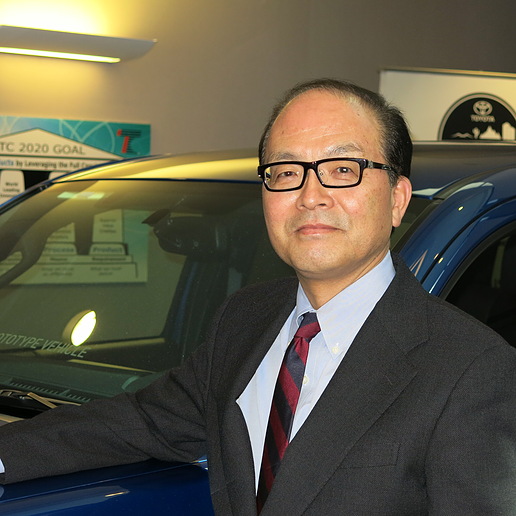 Seiya Nakao:“我们将加快在先进汽车技术方面的合作步伐。”
Seiya Nakao:“我们将加快在先进汽车技术方面的合作步伐。”
“就像房子需要地基一样,SAE正是所有‘工程师’成长的基础,” 丰田北美汽车技术中心总裁Seiya Nakao表示,“当我刚刚成为一名工程师时,我从SAE学到了很多东西。因此,对我个人而言,这也是回报SAE的好机会。”
Seiya Nakao担任了于今年4月在美国底特律举办的SAE 2016全球汽车年会与展览的大会主席,他很激动丰田能在本次大会上担任领导角色,也为公司将在大会期间展示100份技术论文感到十分高兴。Nakao相信,今年的汽车年会及其“Powering Possibilities”的主题,都意味着汽车行业将要扣动新创新的“扳机”。
最近,《SAE汽车工程杂志》在丰田北美技术中心采访了Nakao先生,以下是部分采访内容:
SAE:在您眼中,30年后的汽车将会是怎样的?
Nakao:我相信多样性将会成为趋势。到时候,人们应该会有很多种出行选择,可以自己开车、乘坐自动驾驶汽车,也可以选择汽车共享服务等。但在未来25到30年中,我们仍然无法离开使用汽油的混合动力车,以及插电式电动车,这段时间将是燃料电池和电动车的重要转型期。在未来,还会出现很多非常激动人心的新技术。
SAE:目前,丰田北美技术中心(TTC)正在进行大规模扩张。TTC将在交通运输的新时代中扮演何种角色?
Nakao:我们的主要工作有两个‘支柱’:汽车开发和尖端技术研发。因此,除了继续开发混合动力等现有技术,我们还需要研发新的解决方案 -- 续航里程更长的汽车电池和成本更低的燃料电池系统。当然,还有配套基础设施。
SAE:TTC的角色不仅仅是汽车核心技术的开发吗?
Nakao:在汽车技术研发方面,我们正在开发一些专为美国市场提供的产品,比如Avalon和Tundra。但在我看来,在未来几年中,我们的主要工作将集中在整车开发,比如“K”平台(凯美瑞)。我相信这种转变是必然的。在尖端技术研发方面,我们成立了新的丰田研究所(TRI),进行人工智能及其他先进学科的研究工作(点击详见:丰田推出汽车自动化与高级研究“梦之队”)。人工智能技术可用与打造自动驾驶汽车,我们相信丰田一定可以领跑这一领域。对于电池系统等其他尖端技术而言,我们认为美国是开展这些领域研究的最佳市场。
SAE:您认为未来的电池领域真的会如电池研发人员所说的那样,出现“突破”吗?
Nakao:我该给你一个官方的答案?还是个人的答案呢?[笑]事实上,我希望是这样。但目前我个人并未看到这个领域有什么大的进展,这也算是一直困扰丰田的一个地方。但丰田不会放弃,我们会继续大力进行这些技术的研发。
SAE:丰田公司最近的重组会对产品开发带来什么影响?
Nakao:目前,丰田每年要生产大约1000万辆汽车。但公司的组织结构还与30年前一样,有很多地方都不利于我们开展跨部门的研发工作,也不利于快速做出决定。这就是丰田章男社长决定做出改变的原因。他的目标很清晰,就是要实现快速决策!因此,我们打破了高度集中化的旧组织架构,形成了现在的新结构,从本质而言也就是四个基于产品的分部。
SAE:生产制造部门过去是丰田的“核心”,也是公司盈利的关键,这个部门的员工对公司重组有什么看法吗?
Nakao:丰田生产系统(Toyota Production System)效率高、成本低,是非常棒的系统。但遗憾的是,目前生产部门过于强大了。因此我们有了新想法,我们将在今年4月18日正式发布一个新的生产系统。
SAE:截止到目前,事情进展的怎么样?
Nakao:[轻笑]事实上,这个过程并非一帆风顺!但我们将不断进行改善提高。正如丰田章男所言,‘这与其说是一个解决方案,不如说是一个机会。’
SAE:最近几年,丰田的合作伙伴包括富士重工(Fuji Heavy)、梅赛德斯(Mercedes)、特斯拉(Tesla)和马自达(Mazda)等多家公司。现在,技术和产品开发领域的合作非常重要吗?
Nakao:合作是必要的,特别是在自动驾驶和互联汽车技术研发方面。这些领域的发展如此之快,超乎我的想象。如果丰田想要独自奋斗,那我们将很难跟上这种节奏。正因如此,我们正在与很多研究机构、大学,甚至政府合作。但这还不够,未来我们还将继续加快合作。
SAE:如果谷歌(Google)或苹果(Apple)来找丰田制造他们的汽车,这是不是会很有趣?
Nakao:喔,是的,会很有趣![大笑]我们内部经常讨论这个话题。事实上,智能手机已经成为了汽车的一种标配,如果我们忽视手机在车上的应用,用户就不会满意。因此,我们必须认真考虑如何与这些[技术公司]合作。
SAE:您认为汽车工程这个行业会发生什么变化?
Nakao:我们需要在自动驾驶、人工智能、计算机科学、机器人科学、高级电池化学和纳米技术等领域培养新人才,或招募新人才。在我看来,机械工程仍然是汽车工程的基础,但一些年轻工程师认为这都是‘过时的东西’。我们必须改变人们对这份工作的刻板印象!我肯定,未来的汽车工程师将拥有机械、电气/电子和计算机科学等领域的综合实力。
SAE:您担心现在的年轻人都不愿在一家公司工作很久吗?
Nakao:担心。在我们这个系统中,离职率最高的是拥有5到7年经验的员工。
作者:Lindsay Brooke
来源:SAE《汽车工程杂志》
翻译:SAE上海办公室
Toyota’s 'trigger' for innovation
“SAE is the ‘engineers’ foundation,’” reflected Seiya Nakao. “When I was a young engineer, we learned a lot from SAE, and personally this is a good opportunity for me to return something to it.” Nakao, President of the 1M-ft2 Toyota Technical Center (TTC) near Saline, MI, is serving as General Chairman of the SAE 2016 World Congress and Exhibition. He is clearly excited about his company’s leadership role in the event and the 100 technical papers being presented by Toyota. Nakao believes this year’s World Congress, and its “Powering Possibilities” theme, will serve as a “trigger” for new innovation. Automotive Engineering spoke with Nakao-san recently at TTC; an excerpt from our interview follows:
What is your own vision of mobility in the next 30 years?
I believe in variety. There should be a lot of options for people to choose; driving by themselves, autonomous vehicles, car sharing. But while in the next 25-30 years we will still have gasoline hybrids and PHEVs, this will be a very important transition time for fuel cell and electric vehicles. And it will be hugely exciting for new technology.
TTC is undergoing a big expansion. What role will TTC play in the new mobility era?
Our main job here consists of two ‘pillars:’ vehicle development and cutting-edge technology and research. So while we evolve the current technologies such as hybrid, we also have to develop or invent new solutions—longer-range batteries and affordable fuel cell system. And, of course, infrastructure.
Will TTC take on more of a core vehicle-development role?
In vehicle development we’re now doing U.S.-exclusive product such as Avalon and Tundra. But in the coming years, in my opinion, we will take a main role in full vehicle development, such as the ‘K’ platform [Camry]. That kind of shift in responsibility will happen, I believe. And on the Research side, we created the newToyota Research Institute (TRI), a company that researches artificial intelligence along with other advanced disciplines (http://articles.sae.org/14546/). That technology is used to create autonomous vehicles, and we believe it should definitely be led by us. And other cutting-edge technologies such as battery systems—the U.S.A. is the best place for research in these areas.
Are you confident there will be a battery “breakthrough,” as the battery guys keep promising?
Should I answer that officially or personally? [laughs] Actually, I hope so. But my personal impression is, I haven’t seen good progress in this area. It’s kind of struggling point for Toyota. But we don’t give up; we’re aggressively developing these technologies.
How will Toyota’s recent reorganization impact product development?
We’re now producing 10 million vehicles per year. But our organizational structure was stuck where it was 30 years ago. We had many [silos] that prevented cross-functional engagement and quick decision making. That’s why Akio Toyoda decided to make the change. His purpose is very clear: quick decisions! So we destroyed the old [highly centralized] organization and created what are essentially four product-based divisions.
What do the Production guys—the traditional "core" of Toyota and key to its profitability—have to say about this?
The Toyota Production System is very efficient and low cost—great system. But, unfortunately, Production became too strong! So we have the new idea. We will start the new system April 18, officially.
How are things going so far?
[chuckles] Not so perfect! But we will improve that through kaizen. As Akio Toyoda said, ‘This is not a solution. It is an opportunity.’
Toyota in recent years has collaborated with Fuji Heavy, Mercedes, Tesla, Ford, and Mazda. Are technology and product-development partnering now vital activities?
They are necessary, especially for autonomous and connected-vehicle technology developments. The speed of new developments in those areas is so fast—faster than I expected. If we tried to do it by ourselves, we couldn’t catch up. That’s why we are doing a lot with academia, with a lot of fine universities, and even with government. But even that’s not enough. So we will expedite the collaborations.
If Google or Apple came to you wanting Toyota to build their cars, would that be an interesting proposition?
Oh, yeah! [laughs] Internally we are discussing a lot. The smartphone is kind of the de facto standard already, and if we ignore it, the customer isn’t satisfied. So we have to seriously think of how to collaborate with them [tech companies].
Do you see changes coming in the automotive engineering profession?
We need to develop new talent in autonomous driving, artificial intelligence, computer science, robotic science, advanced battery chemistry, nanotechnology. Or hire them. In my opinion, the foundation is still mechanical engineering, but some young engineers see that as being ‘old-fashioned stuff.’ We have to change the job’s style! I definitely see the future automotive engineer having a combination of mechanical, electrical/electronic, and computer-science engineering competencies.
Are you worried that young professionals no longer stay with the same company for very long?
Yes. The highest turnover ratio in our systems is probably five to seven years’ experience.
Author: Lindsay Brooke
Source: SAE Automotive Engineering Magazine
等级
打分
- 2分
- 4分
- 6分
- 8分
- 10分
平均分
- 作者:Lindsay Brooke
- 行业:汽车
- 主题:环境燃料和能源管理与产品开发噪声、振动与声振粗糙度零部件质量、可靠性与耐久性测试与检验
